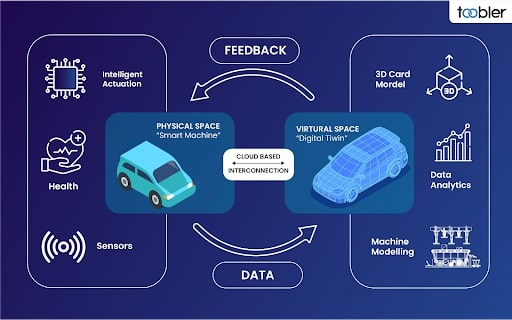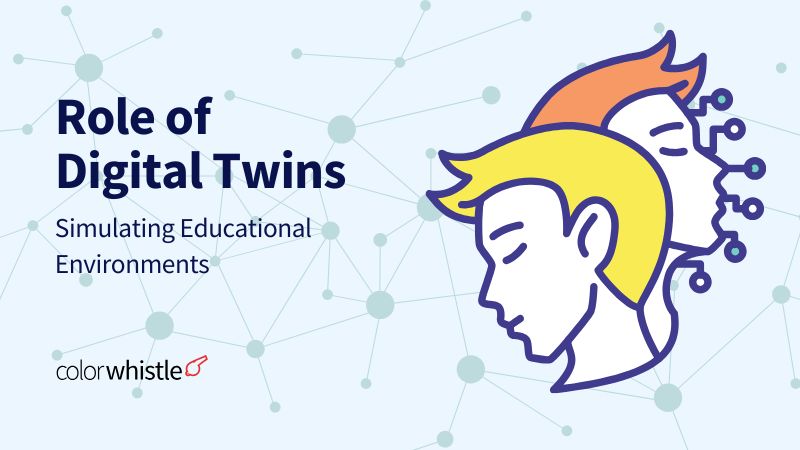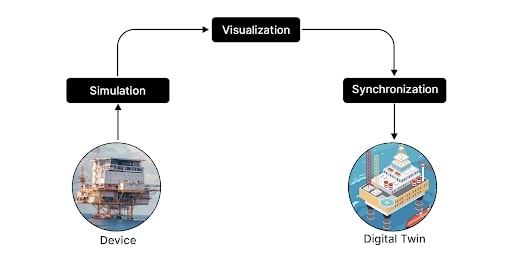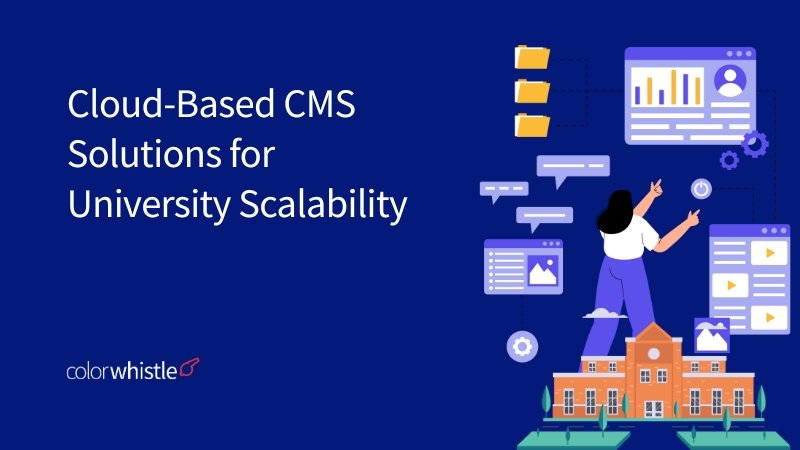What Are Digital Twins?
A digital twin is a virtual model that mirrors its physical counterpart. By using sensors, IoT devices, and real-time data analytics, digital twins provide a comprehensive view of the physical entity’s condition, behavior, and performance.
For example, a digital twin of a classroom replicates its structure, technology, and even human interactions, enabling educators to test scenarios and strategies before real-world implementation.
The Science Behind Digital Twins
Digital twins rely on a combination of technologies
- IoT Sensors: Capture real-time data
- Artificial Intelligence (AI): Predicts outcomes and provides insights
- Data Analytics: Analyzes and optimizes performance
- 3D Modeling: Offers a realistic visualization of the virtual replica
You Should Consider Opting for an AI App Development Services Agency to Start Your Digital Twin Journey!

Applications of Digital Twins in the Educational Environment
Digital twin technologies can be applied in a variety of ways to improve educational environments and outcomes. The following are some applications of digital twins in educational environments
Digital Twin Technology for Teaching Assistant
Digital twins of laboratory equipment enable students to experiment with the equipment both inside and outside the classroom. This allows for the integration of theory and practice. Students can experiment with different scenarios, enhancing their learning experience and improving their situational awareness
- When there is a high risk of mishandling the equipment, digital twins can help students prepare to use live equipment
- Digital twins of large equipment, like an excavator, can provide learners with experience while saving time and money on equipment and transportation
- Digital twins allow for the personalization of learning by enabling students to experiment and explore outside of scheduled class times
Virtual Replicas of Campus Infrastructure Using Digital Twins
Creating a digital twin of a real campus enables simulations to investigate various scenarios that can affect the campus. For example
How might an increase in enrolment affect available space?
How might the introduction of new courses affect overall campus activities?
How might a natural disaster affect buildings and services?
- DTs can help universities manage situations like a pandemic that requires online studies
- DT simulations of online course capacity can help optimize the delivery of online and hybrid learning
Digital Twin Technologies for Learners
The development of human-like digital twins is now feasible. In the educational environment, it is possible to generate learner DTs to enhance student learning capacity.
- DTs can be used to provide real-time feedback to students regarding their academic activities.
- A teacher can change teaching methodologies by analyzing student behavioral patterns to increase student interest.
- Learner DTs can analyze personal and social data through data mining to create a context-sensitive environment to improve learning.
- DTs can be used to provide learners with personalized notifications on time management, reminders for lectures and assessments, and suggested reading lists
Also Read
Simulated Laboratories for STEM Education
- In STEM fields (science, technology, engineering, mathematics), digital twins can simulate laboratory environments. Students can perform experiments in a virtual setting that replicates the behavior of real-world systems
- Enables safe, cost-effective, and scalable practical experiences without the risk of accidents or resource limitations
- It allows for the replication of hazardous or expensive experiments in a controlled virtual environment
Do You Mind Reading? “The Future of Education: Exploring AI, STEM, the Metaverse, AR, and VR”
Teacher and Staff Training
- Virtual simulations of educational scenarios can be used to train teachers and staff in a safe, controlled environment. Digital twins can replicate classroom management, student behavior, or emergency response situations to prepare teachers for a wide range of challenges
- Allows teachers to gain practical experience and improve their skills without real-world consequences, enhancing their professional development
Crowd Simulation in School Events
- Digital twins can simulate crowd behavior in large school events like graduation ceremonies, sports games, or school fairs, helping organizers plan better crowd management strategies
- Ensures safety and helps plan logistical aspects, such as seating, security, and emergency exits
Medical Training Simulations
- In medical education, digital twins can provide realistic simulations of human anatomy and medical scenarios
- Students can perform virtual dissections and practice procedures using digital models of cadavers or organs
- This hands-on approach enhances understanding and retention of complex concepts while preparing students for real-world medical practices
Key Benefits of Digital Twins in Education
Personalized Learning Experiences
- Adaptive Learning: Digital twins can gather data on individual student performance and preferences, allowing for customized learning paths and activities
- Differentiated Instruction: Educators can tailor instruction to meet the diverse needs of students, providing targeted support and challenges
Enhanced Engagement and Motivation
- Immersive Learning: Digital twins create interactive and engaging learning environments that can capture students’ attention and foster a deeper understanding of concepts
- Gamification: By incorporating game-like elements, digital twins can make learning more fun and motivating for students
Improved Accessibility and Equity
- Remote Learning: Digital twins can provide access to high-quality education for students in remote or underserved areas
- Inclusive Learning: By simulating real-world environments, digital twins can help students with disabilities overcome physical barriers and participate fully in the learning process
Data-Driven Decision Making
- Performance Analytics: Digital twins can track student progress, identify areas of improvement, and inform instructional decisions
- Resource Optimization: By analyzing data on resource utilization, institutions can optimize the allocation of resources and improve operational efficiency
Why Choose the Right Digital Twin Provider?
Working with a trusted digital twin provider gives you access to the latest technology, expert guidance, and reliable solutions. These providers have experience in industries like manufacturing, healthcare, and smart cities, ensuring they can deliver solutions that fit your education industry’s exact needs.
Also Read
Connect with Us!
If you’re ready to explore how digital twins can revolutionize your educational or operational environment, connect with our service today.
Wrap-Up
Digital twins facilitate immersive learning, allowing students to engage with complex scenarios safely, particularly in fields like healthcare and engineering. This hands-on approach improves retention and understanding by enabling the practical application of theoretical knowledge. Additionally, they support personalized learning by adapting to individual student needs, thereby enhancing engagement and academic performance.
Browse our ColorWhistle page for more related content and learn about our services. To contact us and learn more about our services, please visit our Contact Us page.
What’s Next?
Now that you’ve had the chance to explore our blog, it’s time to take the next step and see what opportunities await!






